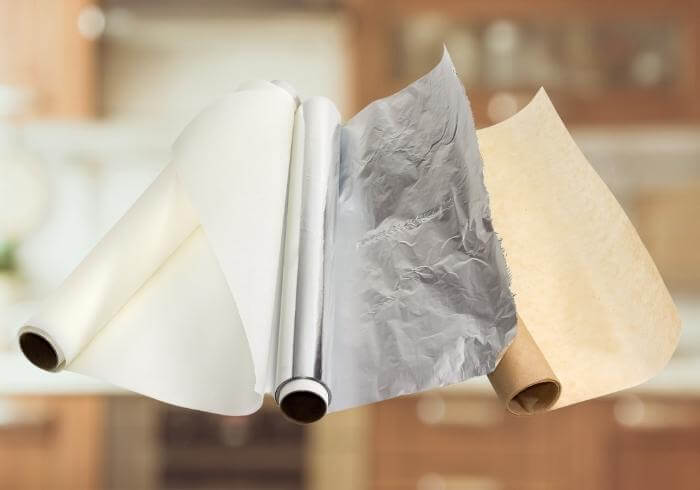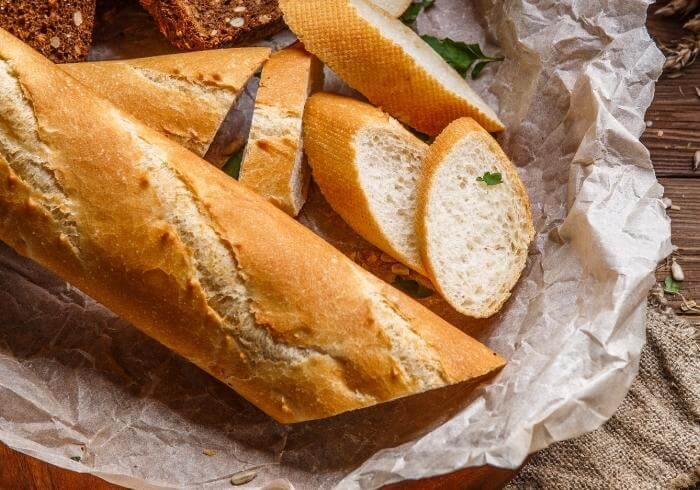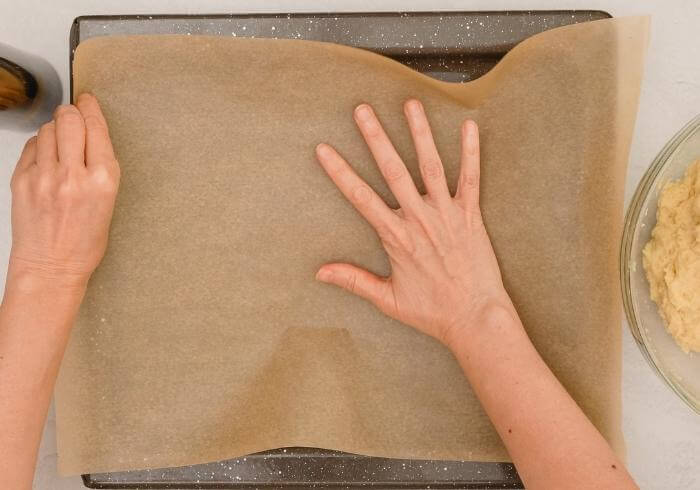Silicone has many uses in the kitchen. The development of silicone bakeware reduces the risk of aluminum exposure and corrosion in your cookie sheets and muffin tins.
Silicone bakeware and cookware are made of a synthetic rubber that contains the natural element silicone in a bonded structure, so it holds its shape and maintains heat resistance.
It’s “natural” so it must be good right? Not always. In this guide, we will cover common concerns about the safety of some of these products.
What Is Silicone Made Of?
Silicone kitchenware is built of silicon and a heat tolerant synthetic rubber material. The silicon in the formula adds non-reactive stability, and the rubber material keeps the bakeware flexible under difficult conditions.

In addition to silicon and synthetic rubber, many styles of silicone cookware contain pigments in all colors of the rainbow.
As a general rule, if the pigmentation is continuous through the product, the silicone bakeware is stable and will tolerate heat, moisture and the rigors of baking.
Is Silicone Plastic?
The synthetic rubber used in the creation of silicone bakeware is based on the formulation of naturally occurring rubber, not on a petroleum product. Plastic is based on carbon at the molecular. Thus, technically, silicone is not a plastic product.
The biggest benefit of silicone cooking tools vs. plastic cooking tools is that silicone has a low reaction to baking heat if not exposed to temperatures of more than 400 degrees Fahrenheit / 204 degrees Celsius.
However, the creation of silicone cookware can introduce many unstable chemicals.
For example, the dyes in the highly colored synthetic bakeware on the market today have probably been chemically formulated and stabilized, and there is no guarantee that those additives are not petroleum-based.
What Is Food Grade Silicone?
Food grade silicone may refer to a lubricant formulated to be non-toxic and stable, or it can be referring to silicone that can be mixed and poured into a custom mold for re-use by the baker.

Both forms are food safe. The first option will simply make it easier to get freshly baked or formed products out of an existing mold, such as a Jello pan or chocolate mold.
The other process of building a custom food safe mold requires the creation of a custom void. The shape desired is built into a mold pan, liquid silicone is poured into the dish to cover the desired shape, and the mold is left to cure.
Is Silicone Toxic?
Concerns about silicone breast implants, leakage and autoimmune responses suffered by some women have led many cooks to wonder about the safety of silicone bakeware and cookware.
It should be noted that silicone breast implants are in liquid form, while silicone kitchen utensils are cured and stable.
However, buyers should beware when purchasing silicone bakeware. Not all manufacturers are alike, and your silicone bakeware may not have been made to the most scrupulous standards.
If you’re purchasing something flexible, put it to the test. You want to confirm that the color saturation of the muffin tin or cake pan is consistent.
Any oddly colored streaks can indicate layers of another product or an incomplete formation of the product, which may lead to outgassing when you get it hot.
When you get your new silicone bakeware home, be sure to run it through the dishwasher. This combination of heat and water should take care of any outgassing and reduce the risk of an odd flavor to your baked goods.
If you use the bakeware more than once and the odd flavor continues, discard both the food and the pan, or get your money back.
SEE ALSO: Tube Pan vs Bundt Pan
Is Silicone BPA Free?
BPA, or bisphenol A, is a plastic additive that keeps petroleum-based materials flexible over time. Because silicone is not a petroleum product, bisphenol A is not a concern.
The synthetic rubber used in the production of silicone bakeware and cookware is inherently flexible and much more heat tolerant than plastic.
This doesn’t mean that it’s completely safe, but the basic components used in the creation of silicone bakeware don’t need plasticizers; it’s inherently flexible.
Silicone Bakeware Dangers
Some users find that silicone bakeware can flex too far and spill batter or baking mixes in their ovens as they’re trying to place pans on the rack. This can lead to smoky messes and dangerous spills.

You will likely need a metal try for your silicone bakeware to sit on inside the oven. The bakeware will flex in the oven and may spill uncooked batter.
Once it’s hot, the silicone is hard to move, so if you’re accustomed to turning your baked goods halfway through the process, be certain to have a cookie sheet or something similar under them.
Silicone bakeware is not nonstick.
You will still need to grease the pans. Also, your baking times will be affected, so take care not to rely on your favorite tried and true recipes without checking on the muffins.
Cooking expert Jolene Thym recommends buttering and flouring all your bakeware before adding batter.
Can You Put Silicone In The Oven?
Silicone will flex when hot, but won’t melt until exposed to 500 degrees Fahrenheit / 260 degrees Celsius. As most baking instructions stay under 400 degrees Fahrenheit / 204 degrees Celsius, melting should not be an issue.
Be prepared for a new odor when you first use your silicone bakeware.
Once you run it through the dishwasher, it should be fine for baking, but it won’t smell like your aluminum cookie sheets.
Related | How To Clean Cookie Sheets
Melting Point Of Silicone
The melting point of silicone is approximately 500 degrees Fahrenheit / 260 degrees Celsius. This doesn’t mean that your silicone won’t flex when exposed to 350 degrees Fahrenheit / 177 degrees Celsius, but it won’t become one with your cake batter.
Melted silicone is extremely dangerous in the household. Should you accidentally overheat your silicone bakeware to the point that it loses form, handle it with great care. This very hot rubber product may well be sticky and cling to skin and clothing.
Are Silicone Baking Mats Safe?
Silicone baking mats are a nice addition to a cookie sheet if you don’t want to grease your metal bakeware. If you’ve ever used parchment paper on top of a metal sheet, investing in a silicone baking mat may work for you.
They are not a replacement for a cookie sheet, however. These flexible mats are far too unstable to use on a bare oven rack.
Silicone can change your cooking times and may require a lower temperature. Also, some bakers find that a silicone baking mat leads to a crustier cookie like Macarons.
Related | How Long Do Macarons Last?
They clean up easily with soap and water and can be rolled up to store. Silicone baking mats can tolerate the dishwasher, but this deep cleaning isn’t necessary after each use.
Is Silicone Bakeware Safe?
To make sure that your silicone bakeware is producing safe food and not burning the cook or damaging your oven, take the following steps:
- Buy from a known and reputable manufacturer
- Put the product to the test before you take it home. Flex it and look for color inconsistencies
- Run it through the dishwasher before you use it the first time
- Always use a metal baking sheet under your silicone bakeware
- Keep it under 400 degrees Fahrenheit / 204 degrees Celsius
- Don’t rely on the timer when baking your old favorites. Be prepared for changes in cooking time
Is Silicone Safe To Cook With?
Silicone tools are subject to the same temperature limitations as silicone bakeware. If you’re stirring a dish in a 400 degrees Fahrenheit / 204 degrees Celsius oven, your spatula or spoon should be fine.
However, you don’t want to use these tools in the broiler as they may become unstable.
Study the edges of your silicone bakeware. They’re supposed to be flexible, but over time they can be damaged and may appear ragged.
These rough edges will limit their heat tolerance, so if these utensils are getting worn, it’s probably time to replace them.
Are Silicone Spatulas Safe?
Silicone spatulas or scrapers are safe at room temperature and up to 400 degrees Fahrenheit / 204 degrees Celsius. Again, if you’re working at hotter temperatures than that, it’s probably best to use a metal utensil.
Also be aware that the internal temperature of a dish may be hotter than the oven if the lid has been on the pan for a while.
If you’re baking a pasta dish or vegetables at 400 degrees Fahrenheit / 204 degrees Celsius and are ready to pull the lid and stir the dish, don’t stick a silicone spatula in there.
Is Silicone Microwave Safe?
Silicone can go from microwave to freezer and back again. Thanks to the flexible nature of the material, you can transfer this cookware easily to the microwave.
Of the many silicone uses in the kitchen, this is one of the most convenient!
Take care when removing silicone dishes from your microwave. Hot food can impact the shape of the silicone and cause it to flex or even get floppy.
Be extremely careful when removing your silicone bakeware so that you’re not burned if the pan flexes or folds badly.
Is Silicone Dishwasher Safe?
As a general rule, it’s a good idea to wash your silicone bakeware in the dishwasher first thing.
Again, silicone flexes when it gets hot, so let it cool down before you empty the dishwasher. Your safety always has to come first!
Final Thoughts
When choosing silicone cookware and bakeware, flex and twist the silicone material and look for white layers or flecks. These non-colored layers may well be fillers and can make that piece of silicone cookware unsafe under high heat.
For silicone to be usable as bakeware, it must be integrous. That means that it can’t pick up flavors from your batter or dish soap.
If you find that your blueberry muffins taste like the last batch of banana muffins or worse, soap, be sure to grease the cups before using.
Should you find that flavor contamination continues, consider discarding the bakeware.











